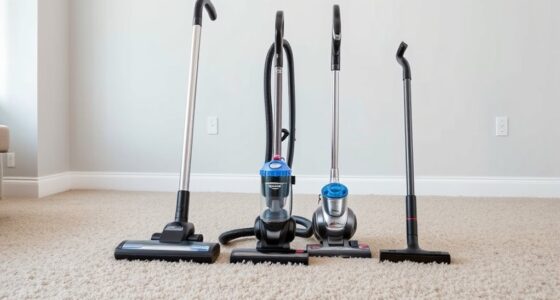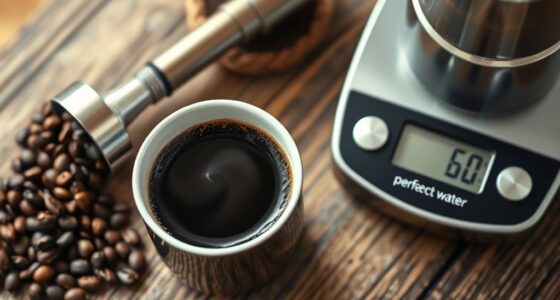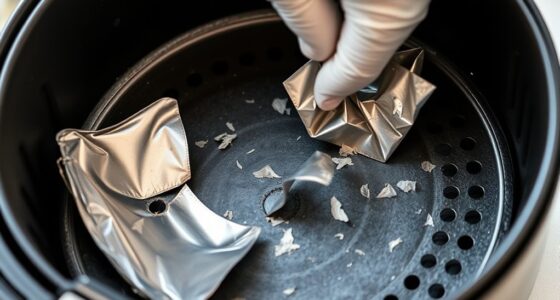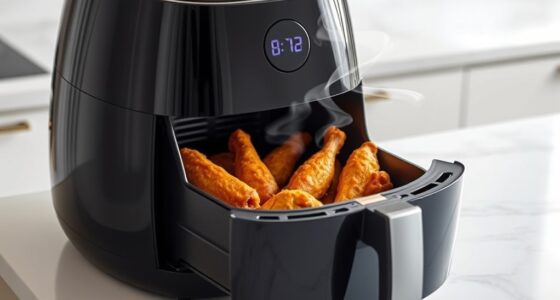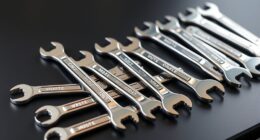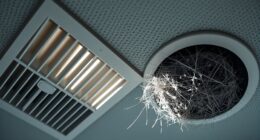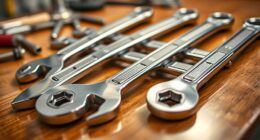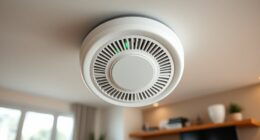If your toaster turns bread unevenly, it’s likely due to misaligned heating elements or calibration issues. You can fix this in minutes by unplugging your toaster, removing the crumb tray, and carefully adjusting the calibration screws with a small screwdriver. Toast a slice and then fine-tune those settings based on the browning. With just a few adjustments, you’ll get evenly toasted bread every time. Keep going to discover more simple tips to maintain perfect toasting results.
Key Takeaways
- Inspect and clean crumbs to ensure proper heat distribution before calibration.
- Use a flat-head screwdriver to access and adjust the calibration screws carefully.
- Toast a plain bread slice with the browning control set mid-level and observe unevenness.
- Make small adjustments to calibration screws, then toast again to check for even browning.
- Repeat adjustments until achieving consistent, evenly toasted bread.
Understanding Why Your Toast Isn’t Even
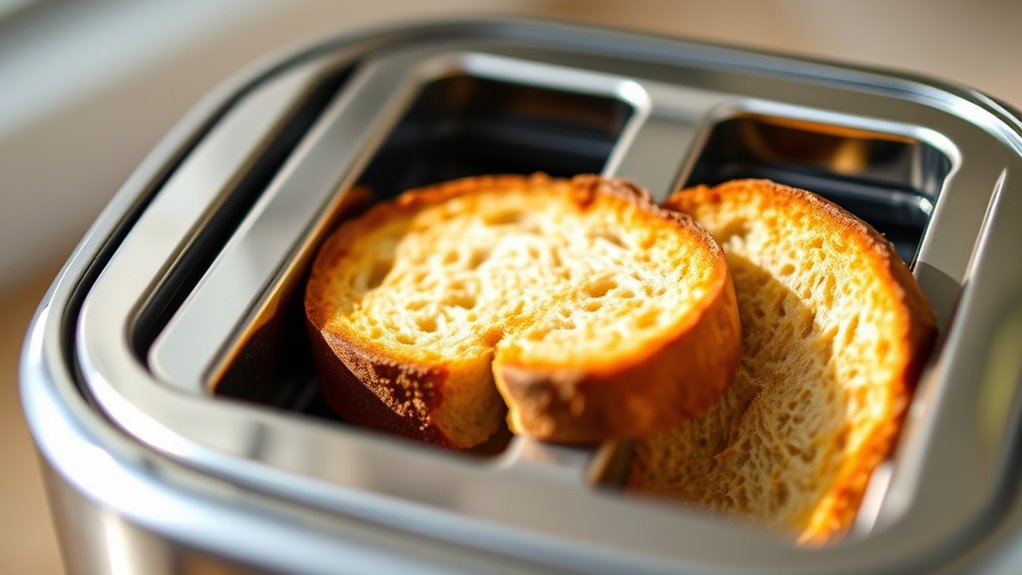
If your toast comes out uneven, the issue often lies in how your toaster is calibrated. Sometimes, the heating elements don’t distribute heat evenly, causing parts of your bread to be toasted more than others. Over time, the internal settings can drift, making your toaster less accurate. Additionally, uneven bread slices or inconsistent placement can lead to uneven results. If you’re using a toaster with adjustable browning controls, inconsistent results might mean those settings aren’t aligned properly. External factors, like leftover crumbs or dirt inside the toaster, can also interfere with heat distribution. Proper calibration ensures consistent toasting quality and can resolve many uneven toasting issues. Regular cleaning and inspecting your toaster can help maintain proper heat distribution and prevent these problems. Understanding these common causes helps you recognize that uneven toasting isn’t always about the bread, but often about your toaster’s calibration and condition. Fixing these issues can give you perfectly toasted slices every time.
Gathering the Tools and Preparing Your Toaster
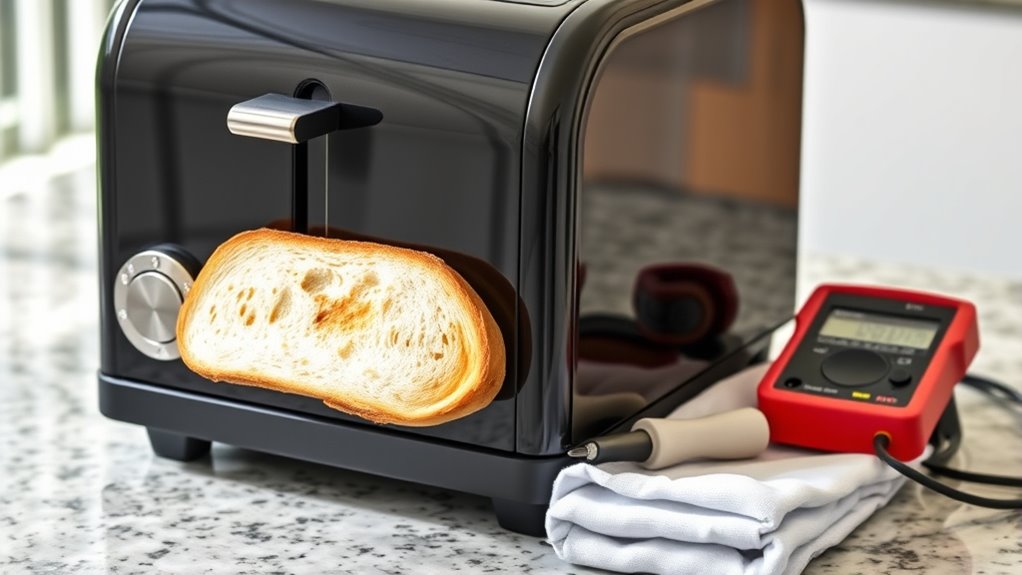
Before you can calibrate your toaster for even toasting, you’ll need to gather the right tools and prepare the appliance. First, grab a few slices of plain bread to test your adjustments. You’ll also want a small flat-head screwdriver or a similar tool to access the calibration screw, usually located at the bottom or side of the toaster. Make sure your toaster is unplugged before opening it to avoid electrical hazards. Clear a clean workspace to avoid losing small parts. Additionally, check that the crumb tray is empty and correctly seated to prevent uneven heat distribution. Understanding the tuning process can help you achieve more consistent toasting results. Recognizing how attention impacts your focus during calibration can ensure more precise adjustments. Being mindful of mindfulness techniques can help maintain patience and accuracy throughout the process. Being aware of AI detection methods can also assist in troubleshooting any digital controls or smart features your toaster might have. Having these tools and preparations in place ensures a smooth calibration process, saving you time and avoiding damage to your appliance. Once everything is ready, you’re set to fine-tune your toaster’s settings.
Step-by-Step Guide to Calibrating Your Toaster
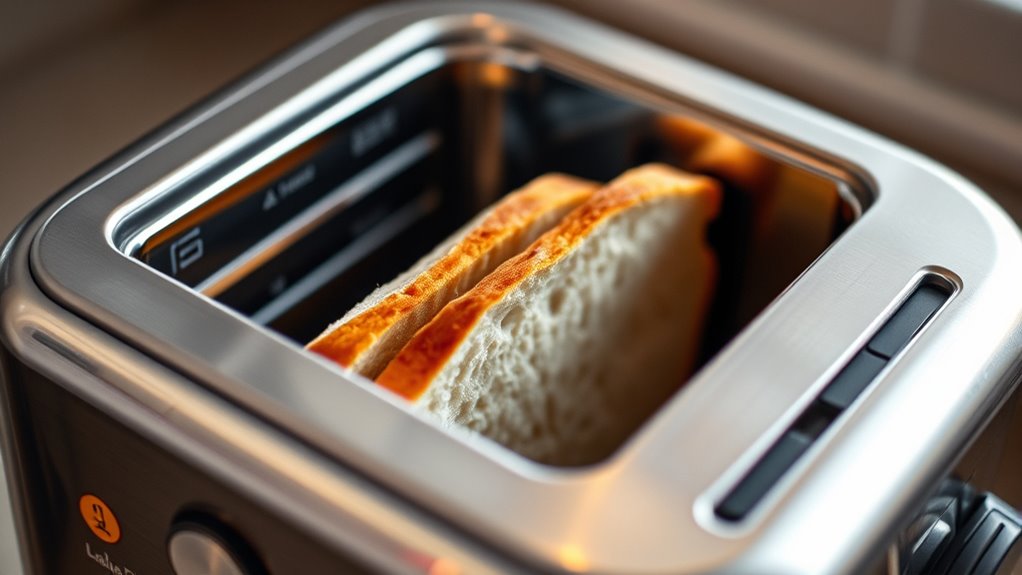
To calibrate your toaster effectively, start by plugging it in and turning the browning control to the midpoint. Toast a slice of bread and observe the results. If it’s uneven, modify the calibration. Use the following table as a guide:
| Step | Action | Result |
|---|---|---|
| 1. Toast initial slice | Observe browning and unevenness | Identify imbalance |
| 2. Adjust controls | Turn the control slightly up/down | Fine-tune to your preference |
| 3. Toast again | Check for even toast | Confirm calibration success |
Repeat these steps until the toast is evenly browned. Calibration is quick and ensures consistent results every time. Remember, factors like bread thickness and moisture can also affect toast evenness, so consider these when calibrating. Additionally, understanding toaster mechanics can help troubleshoot persistent issues.
Testing and Fine-Tuning for Perfect Results
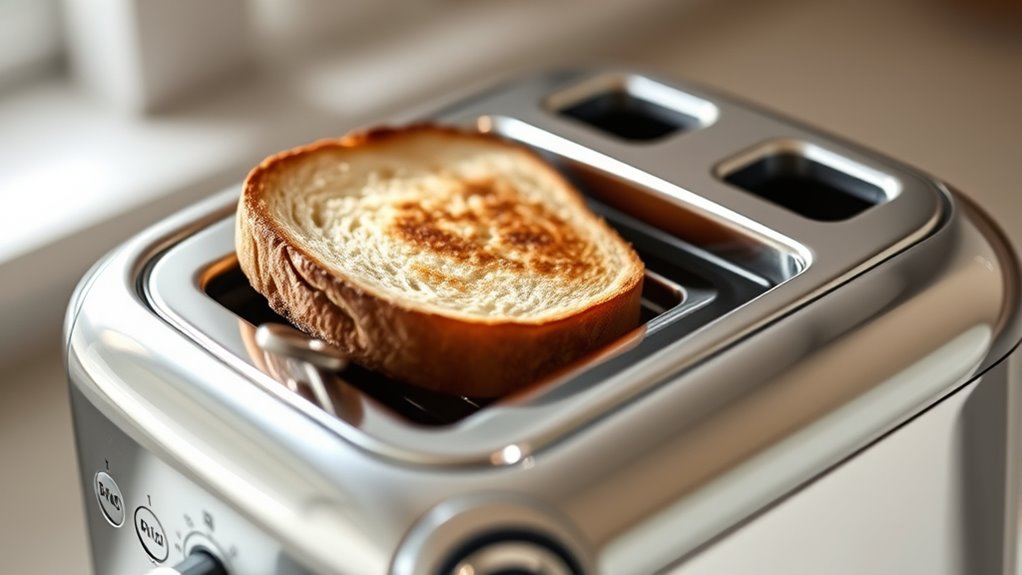
Once you’ve completed the initial calibration, it’s time to test and fine-tune your toaster to achieve perfect results. Start by toasting a slice of bread and observing how evenly it browns. If one side is darker, adjust the calibration slightly—most toasters have a knob or setting to modify the toast level. Repeat the process, making small tweaks after each test, until the bread browns evenly. Keep track of your settings to replicate the perfect toast consistently. Remember, different bread types or thicknesses may require minor adjustments. Patience is key—quick changes might overshoot your target. Once you’re satisfied with the evenness and darkness, you’ve successfully fine-tuned your toaster for top performance. This method ensures consistent, perfect toasts every time. Proper calibration can also be compared to performance tuning in vehicles, where small adjustments lead to optimal results. Additionally, understanding how pimple patches work can help you better manage skin irritation or breakouts, much like fine-tuning your toaster ensures optimal browning. For best results, consider essential oils that can help with skin or health issues, which is akin to making precise adjustments for desired outcomes. Carefully observing the results can also provide insights into your toaster’s settings, allowing you to customize your toasting experience further. Moreover, paying attention to the regulatory standards can help ensure your toaster operates safely and efficiently.
Tips for Maintaining Proper Calibration Over Time
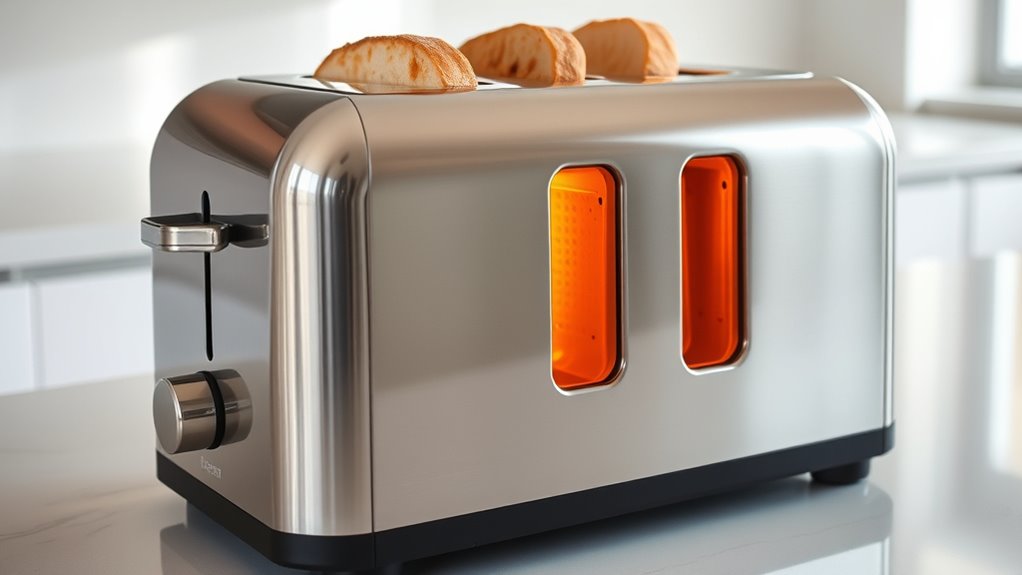
Regularly checking and adjusting your toaster’s settings can help maintain peak calibration over time. Make it a habit to test your toaster every few weeks, especially after moving it or cleaning. Keep track of your preferred browning level, and if you notice inconsistent toasting, recalibrate immediately. Clean crumbs and residue regularly, as buildup can affect heating elements and throw off calibration. Use the same type and thickness of bread when testing to ensure consistency. If your toaster has a calibration feature, revisit it periodically to confirm it still matches your desired settings. Avoid overusing or mishandling the controls, which can cause gradual misalignment. Proper maintenance and understanding of your toaster’s features can enhance performance and prolong its lifespan. Additionally, understanding the basic mechanics of your toaster can help you troubleshoot common issues more effectively. Being aware of how heating elements function and age can inform your calibration process. With consistent checks and gentle adjustments, you’ll keep your toaster performing perfectly for years to come.
Frequently Asked Questions
Can Calibration Fix Uneven Toasting on All Toaster Brands?
Think of calibration as tuning a fine instrument—yes, it can fix uneven toasting on many brands. You can adjust the browning control or internal settings, which helps guarantee consistent results. While some toasters have easy calibration options, others might require more detailed fixes or professional help. So, indeed, calibration often works across brands, making your toast perfectly golden without guesswork.
How Often Should I Recalibrate My Toaster for Optimal Performance?
You should recalibrate your toaster whenever you notice uneven toasting or after moving it to a new location. Regular calibration, about every six months, guarantees consistent performance. If you use your toaster daily, consider checking and recalibrating monthly. Keep an eye on toasting results, and when you see irregularities, take a few minutes to recalibrate. This keeps your toaster functioning ideally and your bread perfectly toasted every time.
Is It Safe to Open My Toaster During Calibration?
It’s generally not safe to open your toaster during calibration, as it involves working with electrical components that can pose shock risks. If you need to calibrate your toaster, unplug it first, then carefully follow the manufacturer’s instructions. Never tamper with internal parts while it’s plugged in. For safety, it’s best to consult the user manual or contact a professional if you’re unsure about the calibration process.
Will Calibration Affect My Toaster’s Warranty?
Did you know over 60% of appliance warranties cover calibration issues? Calibration typically won’t void your toaster’s warranty if you follow the manufacturer’s instructions. Just verify you use recommended procedures and avoid forcing parts. If in doubt, check your warranty policy or contact customer service. Proper calibration can improve performance without risking your warranty, so go ahead and fine-tune your toaster confidently.
Can Calibration Resolve Issues With Burnt or Underdone Toast?
Yes, calibration can help resolve issues with burnt or underdone toast. When you calibrate your toaster, you’re adjusting the settings to guarantee even heating. This fine-tuning helps prevent uneven browning, making your toast perfectly toasted each time. It’s a quick fix that restores consistency, so you don’t end up with burnt or underdone slices. Just follow your toaster’s calibration instructions, and you’ll notice the improvement almost immediately.
Conclusion
Now that you’ve calibrated your toaster, you’re just a toast away from perfect mornings. But beware—the journey doesn’t end here. Keep an eye on how your bread turns out over time; subtle changes could mean your toaster’s precision is slipping. Will your next slice be flawlessly toasted or unexpectedly uneven? Stay attentive, and with each adjustment, reveal the secret to consistently perfect toast—because true mastery lies in the details you might not have noticed yet.


